
When I entered Berlin Cathedral, the word that best described my impression was grandeur. I looked up at the dome’s eight mosaics portraying the beatitudes of the Sermon on the Mount and was almost overcome with a sense of awe, even more of a sense of awe than I had felt when I viewed the western façade of the 98-meter high building. The mosaics by Anton V. Werner were stunning, indeed and my favorite feature of the cathedral.

Mosaics in half-domes of diagonal apses showed the evangelists, and of the four sandstone figures representing personalities in the German Reformation to the left and right of the triumphal arch, I only recognized Martin Luther. There were also statues of John Calvin, a French theologian, pastor and reformer in Geneva; Huldrych Zwingli, a leader of the Reformation in Switzerland; and Philip Melanchthon, the first systematic theologian of the Protestant Reformation who had great influence on the educational system. The cathedral took 11 years to build, from 1894 to 1905. Back then, it was Emperor Wilhelm II’s personal church, constructed in Italian Renaissance style. Today it takes on a neo-Baroque character and stands out prominently in the skyline as I would find out when I walked up the ramp in the dome of the Reichstag, peering down at the marvelous and magical city.
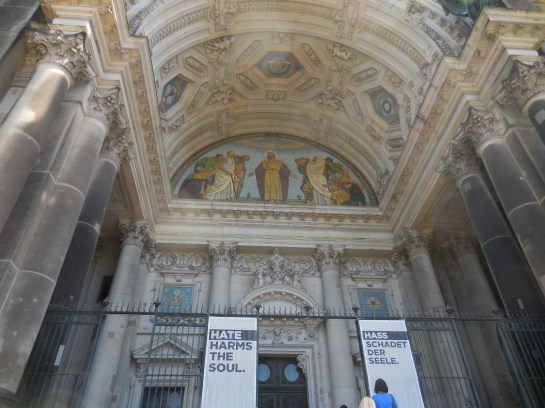
I was aware that the history of the cathedral was a turbulent one. Much of the cathedral had been destroyed by a bomb in May of 1944. That is when the dome had collapsed. Much of the interior had been reduced to ruins, and even the tombs in the crypt hadn’t fared well at all. While reconstruction did not get underway until 1975, it would take many years to do a full makeover so that Berlin Cathedral could once again be a place epitomizing grandeur. The baptism and matrimonial church section was ready for the public within five years, but for the main church, the path back to grandeur would be a very long one. The main church was reopened in 1993, but the reconstruction wasn’t actually finished until 2002.

The sarcophagi in the cathedral were made in various styles, created from an array of materials, making an eclectic display of funerary monuments to significant players in German history. The medieval sarcophagus of Electoral Prince Johann Cicero was the oldest, dating back to the 16th century. While that memorial was bronze, the monument of Emperor Friedrich III was made of marble. King Friedrich I and Queen Sophie Charlotte had golden sarcophagi, both with impressive statuary decoration at the foot of the monuments. I liked the figure of Death writing in a book on the funerary tribute to Queen Sophie Charlotte. Electoral Prince Friedrich Wilhelm and his second wife Dorothea were buried in sarcophagi featuring Baroque elements.

The main altar was made of white marble with yellow onyx columns. Candleholders were created from gilded iron while the Apostles’ Screen was constructed from gilded bronze. I admired the masterful carving of the pulpit with its elegant gold decoration.
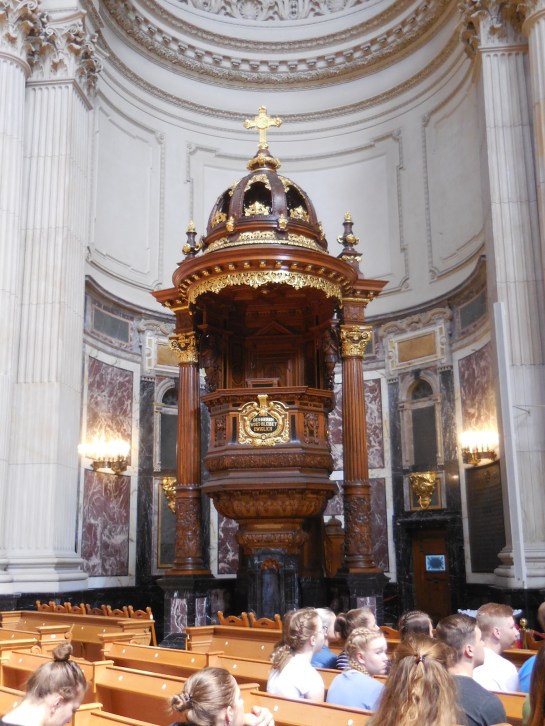
I’ve always admired stained glass windows, and the windows in this cathedral were no exception. I saw stained glass representing the birth, crucifixion and resurrection of Jesus Christ. In another window, a stained glass banner denoting victory symbolized hope.

Four sandstone reliefs showed scenes from the Acts of the Apostles. I admired the majestic atmosphere created by the red velvet banner decorated with gold that was part of the Emperor’s Box, from which the royals would have observed the religious service. Candelabras and a coat-of-arms added to the elegance. The chancel boasted gold decoration in wall panels, for instance.

Built at the same time as the cathedral, the organ was once the largest in Germany. Manufactured by Wilhelm Sauer, the organ is one of the most important instruments of its kind from the German Late Romantic period. It includes 7,269 pipes, 113 stops and four manuals. Later, I was reading about the history of the organ. While it suffered only minor damage during World War II, after the war more than a thousand of its pipes were stolen and sold as scrap metal. The organ was under reconstruction from 1991 to 1993.
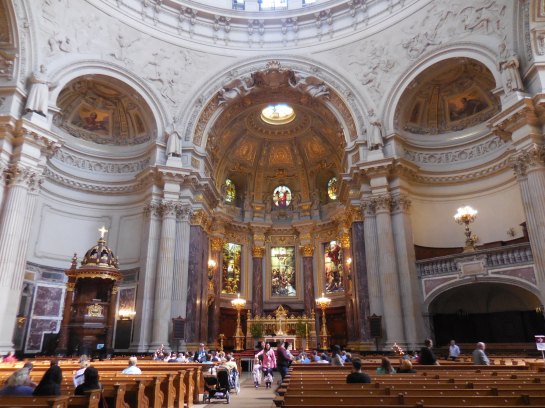
The Emperor’s Staircase added to the superb grandeur of the place, made with various colors of marble and decorated with a gilded bronze chandelier. The golden glass in the doors and panels was also impressive, to say the least. I tried to imagine the nation’s leaders entering by this staircase.
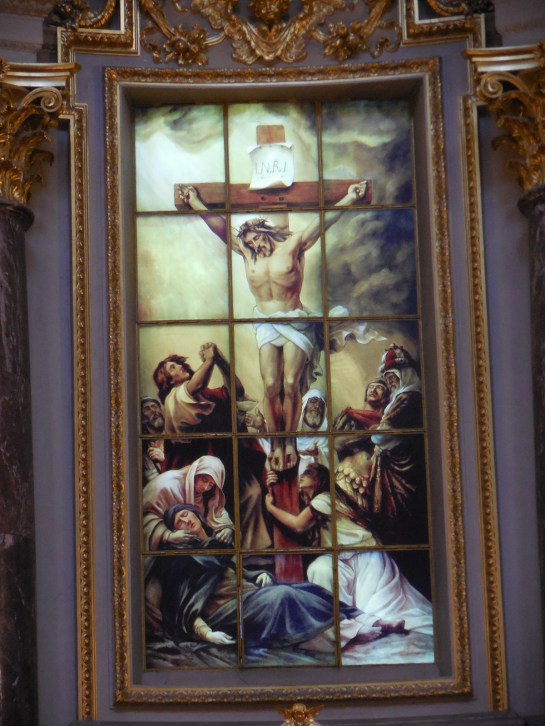
The upper level was not without its delights, either. No less than thirteen wall and ceiling paintings there depicted stories from the life of Christ and parables of Jesus. The baptism and matrimonial chapel, still in use today, flaunted three impressive paintings and a superb organ.
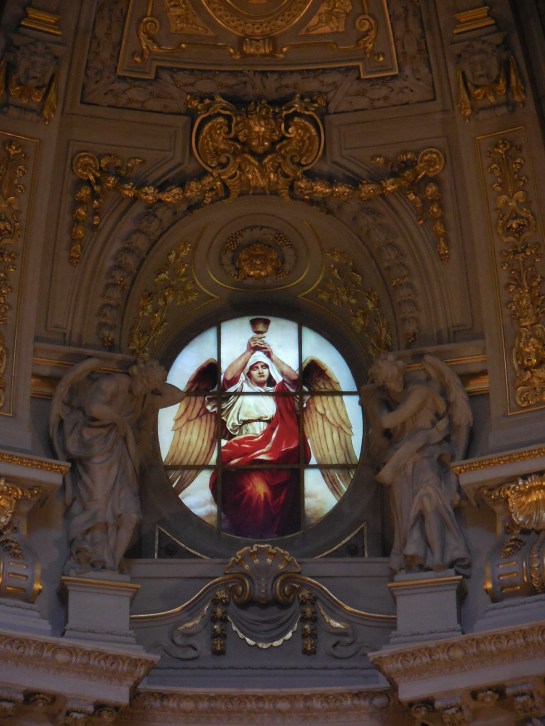
The crypt was a visual narration of 500 years of the prominent figures in history from the Hohenzollern dynasty. There were 94 members of the clan buried in tombs, coffins and sarcophagi, dating from the end of the 16th to the beginning of the 20th century.

I did not remember the cathedral from my trip to Berlin in 1991. At that time, perhaps only the baptism and matrimonial church had been open to visitors as the crypt had been under reconstruction for a while after being severely damaged during the war. I remember that everything was centered on what was then West Berlin in those days, so I may not have even ventured as far as the cathedral site.
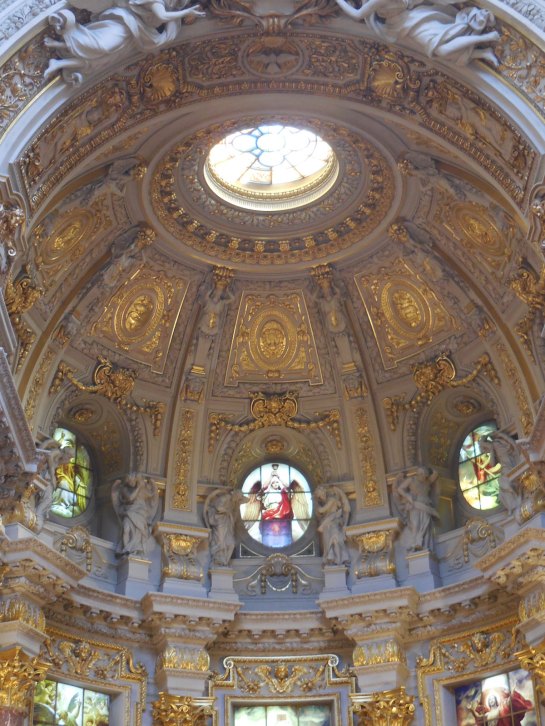
Berlin Cathedral was the first monument I visited during my second trip to Berlin, and I knew that I would be very impressed with the city after my trip got off to such a good start. It was in delightful location, too, on the embankment of the Spree River. From the cathedral, I made my way to museums on Museum Island. There was much to see in a city whose magic was already casting a spell on me.
Tracy A. Burns is a writer, proofreader and editor in Prague.
